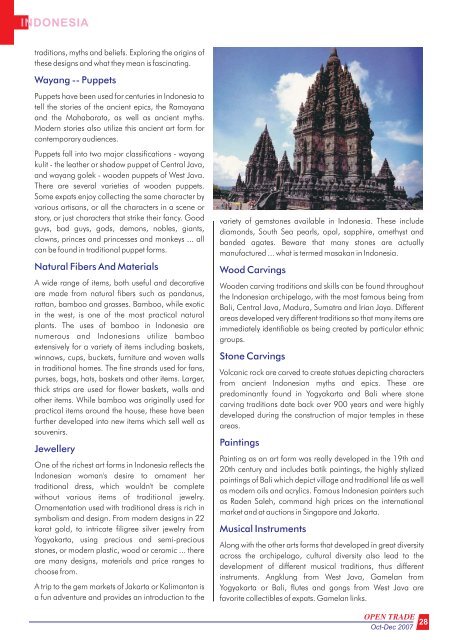pele SciaSction - new media
pele SciaSction - new media
pele SciaSction - new media
You also want an ePaper? Increase the reach of your titles
YUMPU automatically turns print PDFs into web optimized ePapers that Google loves.
INDONESIA<br />
traditions, myths and beliefs. Exploring the origins of<br />
these designs and what they mean is fascinating.<br />
Wayang -- Puppets<br />
Puppets have been used for centuries in Indonesia to<br />
tell the stories of the ancient epics, the Ramayana<br />
and the Mahabarata, as well as ancient myths.<br />
Modern stories also utilize this ancient art form for<br />
contemporary audiences.<br />
Puppets fall into two major classifications - wayang<br />
kulit - the leather or shadow puppet of Central Java,<br />
and wayang golek - wooden puppets of West Java.<br />
There are several varieties of wooden puppets.<br />
Some expats enjoy collecting the same character by<br />
various artisans, or all the characters in a scene or<br />
story, or just characters that strike their fancy. Good<br />
guys, bad guys, gods, demons, nobles, giants,<br />
clowns, princes and princesses and monkeys ... all<br />
can be found in traditional puppet forms.<br />
Natural Fibers And Materials<br />
A wide range of items, both useful and decorative<br />
are made from natural fibers such as pandanus,<br />
rattan, bamboo and grasses. Bamboo, while exotic<br />
in the west, is one of the most practical natural<br />
plants. The uses of bamboo in Indonesia are<br />
numerous and Indonesians utilize bamboo<br />
extensively for a variety of items including baskets,<br />
winnows, cups, buckets, furniture and woven walls<br />
in traditional homes. The fine strands used for fans,<br />
purses, bags, hats, baskets and other items. Larger,<br />
thick strips are used for flower baskets, walls and<br />
other items. While bamboo was originally used for<br />
practical items around the house, these have been<br />
further developed into <strong>new</strong> items which sell well as<br />
souvenirs.<br />
Jewellery<br />
One of the richest art forms in Indonesia reflects the<br />
Indonesian woman's desire to ornament her<br />
traditional dress, which wouldn't be complete<br />
without various items of traditional jewelry.<br />
Ornamentation used with traditional dress is rich in<br />
symbolism and design. From modern designs in 22<br />
karat gold, to intricate filigree silver jewelry from<br />
Yogyakarta, using precious and semi-precious<br />
stones, or modern plastic, wood or ceramic ... there<br />
are many designs, materials and price ranges to<br />
choose from.<br />
A trip to the gem markets of Jakarta or Kalimantan is<br />
a fun adventure and provides an introduction to the<br />
variety of gemstones available in Indonesia. These include<br />
diamonds, South Sea pearls, opal, sapphire, amethyst and<br />
banded agates. Beware that many stones are actually<br />
manufactured ... what is termed masakan in Indonesia.<br />
Wood Carvings<br />
Wooden carving traditions and skills can be found throughout<br />
the Indonesian archipelago, with the most famous being from<br />
Bali, Central Java, Madura, Sumatra and Irian Jaya. Different<br />
areas developed very different traditions so that many items are<br />
im<strong>media</strong>tely identifiable as being created by particular ethnic<br />
groups.<br />
Stone Carvings<br />
Volcanic rock are carved to create statues depicting characters<br />
from ancient Indonesian myths and epics. These are<br />
predominantly found in Yogyakarta and Bali where stone<br />
carving traditions date back over 900 years and were highly<br />
developed during the construction of major temples in these<br />
areas.<br />
Paintings<br />
Painting as an art form was really developed in the 19th and<br />
20th century and includes batik paintings, the highly stylized<br />
paintings of Bali which depict village and traditional life as well<br />
as modern oils and acrylics. Famous Indonesian painters such<br />
as Raden Saleh, command high prices on the international<br />
market and at auctions in Singapore and Jakarta.<br />
Musical Instruments<br />
Along with the other arts forms that developed in great diversity<br />
across the archipelago, cultural diversity also lead to the<br />
development of different musical traditions, thus different<br />
instruments. Angklung from West Java, Gamelan from<br />
Yogyakarta or Bali, flutes and gongs from West Java are<br />
favorite collectibles of expats. Gamelan links.<br />
OPEN TRADE 28<br />
Oct-Dec 2007

















